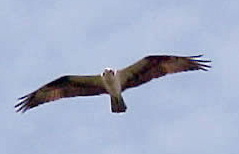 The Osprey population of the Chesapeake Bay region has been adversely affected by the decline of Menhaden, a small fish, along the Atlantic coast. The Chesapeake has one of the largest breeding populations of Osprey anywhere, with close to 4,000 pairs. Within the last decade, researchers have found increasing numbers of malnourished and dying chicks. They argue that this is because the Ospreys' preferred food, Menhaden, has declined sharply over the past two decades.
The Osprey population of the Chesapeake Bay region has been adversely affected by the decline of Menhaden, a small fish, along the Atlantic coast. The Chesapeake has one of the largest breeding populations of Osprey anywhere, with close to 4,000 pairs. Within the last decade, researchers have found increasing numbers of malnourished and dying chicks. They argue that this is because the Ospreys' preferred food, Menhaden, has declined sharply over the past two decades.Menhaden filter the bay's waters by eating the microscopic plants and animals that consume dissolved oxygen needed by other aquatic life. In turn, they're a primary food source for sport fish, such as striped bass, bluefish and weakfish, and seabirds, including loons, gulls and gannets.
Ongoing scientific research focuses mostly on the ecological role that menhaden fill underwater. Broader public awareness has centered on the fish's importance to recreational anglers. But, like striped bass, ospreys favor meals of menhaden over other fish.
"Of everything we know about the bay, this is one of the fundamental food chains: Ospreys eat menhaden," said Paul Spitzer, a Maryland ecologist who specializes in birds.
One study found that menhaden made up 70 percent of the diet of ospreys nesting on Mobjack Bay off the coasts of Gloucester and Mathews counties.
Other studies done along the Atlantic coast have turned up similar results.
Menhaden swim in large schools that skim the water's surface, and they move straight ahead rather than dart around like other fish.
That makes them a perfect prey for circling ospreys, as well as Omega Protein's spotter planes, which radio a school's coordinates to waiting boats.
A fishery commission is considering imposing limits on harvesting of Menhaden while more research is done to determine the causes of the fish's decline.

No comments:
Post a Comment